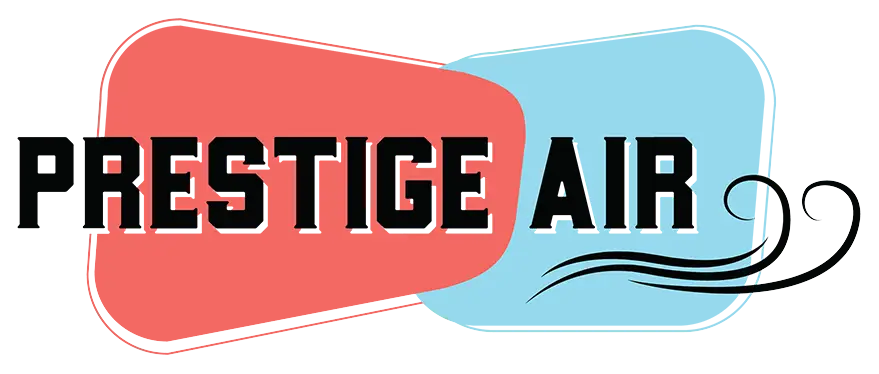
Prestige Air is proud to now offer full indoor air quality assessments with the Air Advice indoor air quality monitor.
In this post I want to take a moment to explain how the assessment works and Aldo go over how to read the Air Advice report.
First, How the Assessment Works
- We show up at your home and set the device in a centrally located area.
- Then we turn on your HVAC system fan to circulate air in the home
- We plug in and turn on the monitor
- We wait for the assessment to complete. This is a 30 minute process
- We review the report with you and discuss any concerns
As you can see the process is quite simple. But in the ease and simplicity comes a ton of valuable information. This monitor evaluates multiple types of pollutants to the air in your home. It measures particles, chemicals and other volatile organic compounds like formaldehyde, carbon dioxide, carbon monoxide, relative humidity, and temperature.
How to Read the Report
Below are the categories and the explanation that comes on each report.
Particles

Health Concerns Particles are generally a cause for concern w hen daily average levels are above 10 μg/m3. Particles are know n to trigger asthma and allergy symptoms. At levels above 35 μg/m3, they can harm normally healthy adults by causing emphysema and diminished lung capacity. Children, the elderly, pregnant w omen and individuals with preexisting lung conditions are more susceptible.
What We Found In Your Home Particle levels were above 35 μg/m3.
Potential Causes Particles can build up to unhealthy levels due to three primary causes: Activities in the home. Presence of excessive particulate sources can cause Heating and cooling system issues.
Recommended Actions
- Replace filters or upgrade filtration system
- Upgrade thermostat to operate HVAC system fan on a schedule to more completely filter airborne particles Inspect duct work; seal and clean as necessary
- Install UV light in the A/C cooling coil to prevent biological growth
- Use range exhaust fan when cooking
Chemicals

Health Concerns Chemical pollutants are generally a cause for concern w hen average levels are above 500 μg/m3 (micrograms per cubic meter of air). Chemical pollutants are know n to trigger asthma and allergy symptoms. At moderate levels, eyes and nasal passages can be irritated. Some people can experience nausea and headaches. At very high levels, they can even affect normally healthy adults by overworking the liver and kidneys. Children, the elderly, and pregnant women are more susceptible.
What We Found In Your Home Chemical pollutant levels were between 501-3000 μg/m3.
Potential Causes Levels can build up in your home’s air due to usage of chemical products and heating/cooling system issues:
Sources: Off-gassing from building materials, carpeting, furniture and other synthetic materials, fuel fumes, scented products and air fresheners, personal care products, household products such as paint, glue, and plastics
Possible heating & cooling issues: Lack of fresh air introduced into home (either inadequate mechanical ventilation or none present), no chemical pollutant removal equipment
Recommended Actions
- Install an energy efficient ventilation device, such as a heat or energy recovery ventilator (HRV or ERV)
- Install a VOC reduction device such as a photocatalytic oxidizer (PCO)
- Install carbon filtration to capture VOCs
- Upgrade thermostat to operate HVAC system fan on a schedule
- Minimize use of VOC sources such as air fresheners, open cleaning fluids, or candles
- Use range exhaust fan when cooking
Carbon Dioxide

Health Concerns Carbon dioxide (CO2) levels above 750 ppm (parts per million) are a cause for concern. At higher levels, CO2 inside a home can contribute to w hat the EPA terms “sick building syndrome,” which leads to fatigue, headache, breathing difficulties, nausea, strained eyes and itchy skin. CO2 poisoning, however, is very rare. The U.S. EPA recommends a maximum concentration of CO2 of 1000 ppm (0.1%) for continuous exposure
What We Found In Your Home Carbon dioxide levels were above 1000 ppm.
Potential Causes Elevated carbon dioxide levels can occur in the homedue to source causes, home heating & cooling system issues, or both:
Sources:
- ‘Tight’ (well weatherized and energy-efficient) home construction without adequate ventilation, common human & household activity (breathing, and burning candles, gas, wood, or other combustion)
- Possible heating & cooling issues: Lack of supplied fresh air (no ventilation), malfunctioning ventilation, ventilation shut off by occupant, HVAC equipment needs repair or service
Recommended Actions
- Install an energy efficient ventilation device, such as a heat or energy recovery ventilator (HRV or ERV)
- Use range exhaust fan w hen cooking
Temperature

Comfort Concerns Comfortable temperatures fall within the range of 68 and 75 degrees F. In addition temperatures are most comfortable when steady, with fluctuations less than 1-1/2 degrees. Ideally, temperature should be constant between all areas of the home. People experience a chilling or ‘goose bump’ sensation w hen temperatures are uneven and when air blows quickly across the surface of the skin.
Potential Causes Fluctuating and/or low and high temperatures can occur due to structural causes and/or home heating & cooling system issues:
Structural causes: Poor insulation, inadequate weatherization (for example, poorly sealed window s and doors create drafts)
Possible heating and cooling issues: Thermostat poorly located (in an area w here air supply falsely influences readings), uneven heating or cooling from room to room due to imbalanced ductwork or inadequate or poorly sized equipment
Recommended Actions
- Upgrade to programmable thermostat for improved accuracy and energy savings
Relative Humidity

Comfort and Health According to the ALA the relative humidity should be near 50% w hen possible. When air is too dry, people typically feel colder, and respiratory passages can become irritated and prone to infection. Conversely, air that is too moist defeats perspiration, the body‘s natural cooling mechanism. High moisture also can lead to condensation within walls and on windows, which can cause mold.
What We Found In Your Home The relative humidity levels were outside the normal range.
Potential Causes Fluctuating and/or low and high relative humidity can occur due to structural causes and/or home heating & cooling system issues:
Structural causes: Standing w ater in basement or other areas, leaky pipes/faucets, inadequate ventilation in w inter (causes moisture build-up inside), and home is under “negative pressure” (pulls dry or moist air in from outside)
Possible heating & cooling system issues: no or inadequate humidification or ventilation, improperly sized cooling system (prevents dehumidification), HVAC equipment needs repair (condensate drain or coil malfunctioning)
Recommended Actions
- Install a dehumidification system
- Inspect ductwork; seal and clean as necessary
- Install UV light or photocatalytic oxidizer (PCO) in the A/C cooling coil to prevent biological growth
- Operate bathroom fans during and after bathing.
- Install ASHRAE-compliant bathroom fan switch
- Use range exhaust fan when cooking
Carbon Monoxide

Safety Concerns Carbon monoxide replaces oxygen in the blood, and is a cause for concern w hen average levels are 6 ppm or higher. When levels are above 25 ppm, immediate action should be taken. Carbon monoxide is a colorless, odorless, poisonous gas produced by combustion. When people are exposed to relatively low levels, it can cause headaches and nausea. At relatively high levels it can cause memory problems and untimely death.
What We Found In Your Home Carbon monoxide levels were below 6 ppm.
Potential Causes Elevated carbon monoxide can occur due to source causes, home heating & cooling system issues, or both:
Sources: Fireplaces, cooking, combustion appliances (water heater, gas dryer, stove), vehicles running in attached garage
Possible heating & cooling system issues: Cracked heat exchanger on furnace, leaking chimney or vent, inadequate exhausting of a combustion appliance (water heater, gas dryer, stove)
Recommended Actions
- Install or check CO alarm(s) per local code
Wrapping Up…
You can see from the examples given above how invaluable this information can be as it pertains to the health of everyone living in your home. That is why we invested the money in a monitor of this caliber and are now doing FREE indoor air quality assessments.
If you or someone in your home experiences issues with allergies, asthma, itchy, watery eyes, or restless sleep call Prestige Air. Our expert service professionals have the training and experience to assess the quality of the air in your home. Check out our indoor air quality services online or call (817) 200-7215 to make sure the air you’re breathing is healthy and revitalizing!
Prestige Air proudly serves Northeast Tarrant County and the Fort Worth, Texas area including Hurst, Euless, Bedford, Colleyville, Grapevine, Southlake, Keller, Watauga, Haltom City, and North Richland Hills.
We look forward to serving you and your household!

